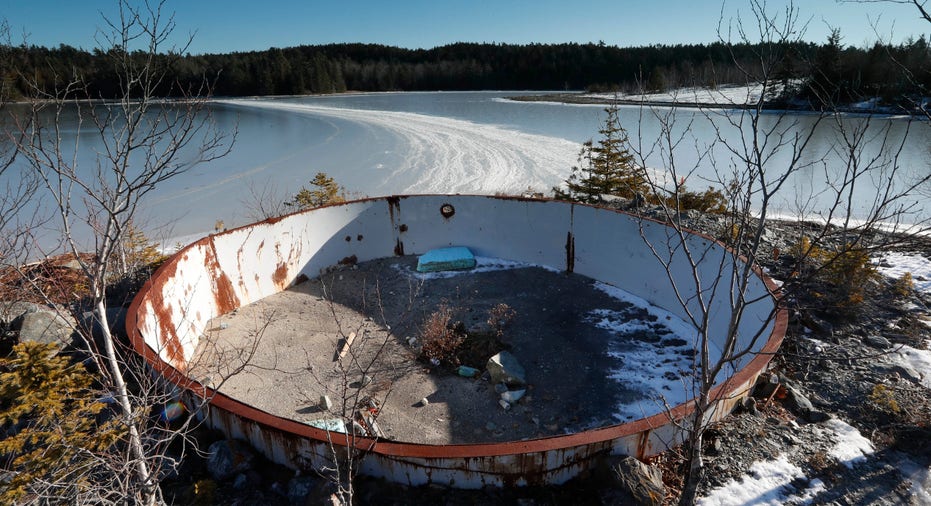New England confronts little-known, messy legacy of mining

BROOKSVILLE, Maine – Think of New England industry, and mills, farms and lobsters come to mind. But the region also has a sometimes-messy legacy of mining — and the bill is due.
Companies that once pursued copper, iron and other ores have abandoned half a million mines nationwide and left the cleanup to taxpayers, thanks to decades of lax regulation. Though the vast majority of such hard-rock mines are in the West, taxpayers are on the hook for more than $80 million in cleanup at two mines in Maine and Vermont.
Those mines, along with two others in Vermont, are on the Environmental Protection Agency's list of national priorities. States have to pay 10 percent of such cleanup cost when EPA funds are used.
The Callahan mine in Brooksville, Maine, has a $500,000-a-year price tag for Mainers, and estimates of its remediation cost have ballooned from $23 million to $45 million. Maine lawmakers are pointing to the mine to justify a new, widely supported bill that supporters say would ensure mining companies never again fold up and leave taxpayers on the hook.
There's a bit of buyer's remorse involved. Republican Sen. Tom Saviello noted that Maine officials were "active participants" in the mine.
"We leased them land, permitted it and we actually passed legislation to allow them to go mine," he said.
Now, the new regulations would be "more restrictive than anyone else in the nation," Saviello said.
In the 1960s, the Callahan Mining Corp., of New York City, drained Goose Pond in Brooksville for an open-pit copper, zinc and lead mine. It made the company about $1 million, was closed after five years and then was flooded by the opening of a dam.
"It's a crazy place to have a mine," said Democratic Rep. Ralph Chapman. It's the nation's only open pit mine in a coastal estuary system, he said.
Spent shotgun shells and broken appliances lay scattered about a massive pile of waste rock known as Callahan Mountain. Rainwater and snowmelt have long leached metals from a nearby artificial pond made up of the slimy waste produced when separating minerals from rocks.
A 2013 study in the Archives of Environmental Contamination and Toxicology found that metals from the mine are widespread in nearby sediment, water and fish — a suggestion that decades later, toxic metals still seep from the mine's waste rock piles and debris and pose a danger to marine and coastal animals and those who eat them.
Maine's new bill would require any company seeking a mining permit to set aside funds — including cash — for the costs of a "worst-case catastrophic mining event or failure." It would also require a third-party review of the cleanup and restoration estimate.
The bill would affect only future licenses and would not retroactively compel cleanup at mines, such as Callahan, that have already been shuttered. Callahan Mining was acquired in 1991 by Coeur Mining, which does not believe it's liable for cleanup costs, according to a 2015 annual report filed with the U.S. Securities and Exchange Commission.
Dozens of Mainers have written to legislators saying they don't want the financial or environmental risk of a mining disaster, period.
"You don't live up here because it's easy to live up here. You live up here because you love it," said Shelly Mountain, who inherited a camp on a lake near Bald Mountain, where the owner of a mineral deposit has long sought to open a mine but has been stymied by environmental opposition. "And if it's ruined, then there's no reason to live up here anymore."
Vermont was the nation's chief copper producer until the mid 1800s. The closing of the Elizabeth Mine in South Strafford in 1958 brought an end to metal mining in Vermont and left behind contaminated soil and groundwater.
Since 2003, the EPA has repaired a failing dam, relocated mine waste and cleaned up a factory at the site. But South Strafford resident John Freitag, a member of the town's selectboard, said that since then, cleanup costs are siphoning attention from farm-runoff pollution in 160-mile-long Lake Champlain.
"Given all the needs we have, if you're going to use taxpayer dollars, you have a responsibility to use those as effectively as possible," Freitag said.
The EPA says cleanup estimates can increase because it's hard to gauge how much material must be remediated. For instance, the EPA originally estimated Callahan Mine had 4,000 tons (3,628 metric tons) of contaminated material, but the actual volume was about 34,000 tons.
The administration of Republican President Donald Trump has delayed consideration of a federal proposal to require the nation's mines and processing facilities to prove they have the financial wherewithal to clean up polluted mining.
The EPA estimates the regulations could cost American business up to $171 million. And the mining industry isn't happy.
The federal rules would create an "enormous and unjustifiable burden" while jeopardizing mining jobs and "increasing reliance on foreign minerals," Hecla Mining Co., based in Coeur d'Alene, Idaho, said in written comments to the EPA in March. The company does not have mines in New England.
As for Maine, no metals have been mined there since 1977. And given the state's bill, said Graham Davis, a professor at the Colorado School of Mines, "I think it's fair to say that most companies would not be interested in doing that."



















